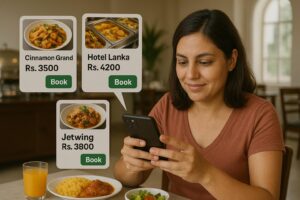More individuals are choosing the convenience of having meals delivered right to their door as a result of the rising popularity of food delivery applications. But have you ever taken the time to figure out how much you're actually paying for that convenience? Even if the menu price may seem fair up front, delivery services frequently have additional fees that greatly increase your total. Let's examine how fees, shipping charges, and other unstated costs might build up and cause you to pay more than you initially anticipated. On top of delivery fees, many food delivery apps include service fees that can range from a few extra dollars to a percentage of your order total. These fees may be labeled in various ways, such as "small order fees" or "convenience fees," and they can quickly add up. For instance, a 1500 LKR meal could turn into a 2500 LKR expense after all the additional costs are calculated. These hidden charges are often tucked into the final checkout screen, leaving customers surprised by the actual cost once the payment is processed.
Delivery Fees: A Direct Hit on Your Wallet
One of the most obvious additional costs of ordering food for delivery is the delivery fee itself. Many delivery apps charge anywhere from LKR 700 - 1500 per order as a standard delivery fee. While it may seem small at first glance, these fees can add up quickly. Ordering food multiple times a week could easily cost you an extra LKR 10,000 to 15,000 over a month in just delivery fees. For premium delivery services, the fees can be even higher, especially if you're ordering from a restaurant that’s farther away or during peak hours. Some apps even add surge pricing during busy times, which could spike the cost even more.
Service Fees: The Hidden Charge
On top of the delivery fee, most delivery services tack on a service fee, typically ranging between 5% and 15% of your total order cost. This fee is meant to cover operational expenses and is often separate from the delivery fee. Even though it’s a percentage of the order, it can feel sneaky, as it’s not clearly communicated upfront. For example, if your meal costs LKR 4000, you could end up paying an additional LKR 200 to 600 just in service fees, a cost that’s not reflected in the restaurant’s original pricing. Many consumers don’t realize this charge until they reach the checkout screen, where the true total becomes apparent. Combined with the delivery fee, this extra cost adds up over time.
Subscription Services and Memberships
Many customers sign up for monthly membership plans offered by delivery platforms that offer free or discounted delivery rates in order to cut delivery costs. Nevertheless, these subscriptions frequently have a monthly fee, usually between LKR 1000 and LKR 2000. Even though this could ultimately save you money on delivery costs, it's still an extra cost that raises your entire food budget, particularly if you don't order often enough to make the membership worthwhile.
Tipping and Its Impact
Most delivery apps suggest a tip of 10-20% of your total order. While tipping is a kind and customary gesture, it’s an additional cost that many people don’t account for when ordering food. If your meal costs LKR 3500, a 15% tip would add another LKR 525 to your bill. When combined with the delivery fee, service fee, and increased menu prices, the total cost of a delivered meal can be significantly higher than if you’d picked it up yourself or dined in.
Conclusion
When you consider all the additional costs, delivery fees, service charges, higher menu prices, and tips, the convenience of having your meal delivered starts to come with a hefty price tag. For frequent users, these costs can add up to thousands of rupees each month, far more than if you had picked up your meal in person.
Ultimately, while food delivery is convenient, it’s worth thinking twice about whether that convenience is worth the extra cost. By picking up your food instead, you not only avoid inflated prices and fees but also get your meal fresher and faster. So, the next time you feel tempted to order in, consider saving your wallet and opting for pickup instead.
This simple switch could save you a significant amount of money over time, money you could put toward other essentials or even a vacation. After all, there’s a lot you can do with the money you save when you take control of your food experience. With RUSH browse a wide selection of restaurants without inflated prices, Avoid hidden fees and unnecessary charges, Save time by ordering ahead and skipping the wait, and support local businesses by dealing directly with them.




